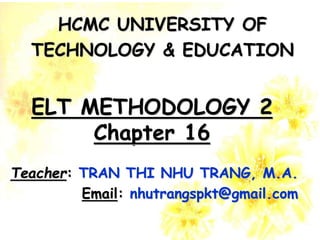
Lecture notes 2
- 1. Teacher: TRAN THI NHU TRANG, M.A. Email: nhutrangspkt@gmail.com ELT METHODOLOGY 2 Chapter 16 HCMC UNIVERSITY OF TECHNOLOGY & EDUCATION
- 3. THE KEY SUBJECT MATTER OF ELT (Scrivener, 2005) Language Systems Language Skills Discourse
- 4. A sentence: Pass me the book.
- 5. Imagine that this cake were a language.
- 6. In order to study a language, structuralism subdivides it into the following parts: In last two hundred years there were 3 important approaches of Language systems, first the structural, covered the study of Language and divided it in: Phonology Lexis Vocabulary Grammar Then the linguistics clasified at 3 levels : phonology, morphology and syntax.
- 7. Then the linguistics clasified at 3 levels : phonology, morphology and syntax. phonology morphology syntax finally the communicative approach adds 2 more units situational and functional aspects. functional situational
- 8. Phonology Lexis Vocabulary Grammar morphology syntax functional situational Language Systems It is important to know Language Systems because we need to know how a Language works, how it is formed or constructed.
- 9. Helps us to know the sounds of a language. Concerns about meaning of individual words or groups of words. How words interact with each other within the sentence. Is the identification, analysis and description of the structure of morphemes and other units of meaning in a language such as words, affixes, parts of speech
- 10. Is about the rules and principles that govern the sentence structure of any individual language Helps us to understand when is proper to use an expression and what expressions are commonly used in certain situations.
- 11. Language systems • Lexis • Grammar • Function • Phonology • Discourse Focus on the significance of words (vocabulary) Focus on the relationship of words within the sentence Focus on the situations in which the words are used Focus on the sounds Focus on the relationship of sentences or phrases according to their functions
- 12. Commonly combined systems focus in many language lessons would be: GRAMMAR + PRONUNCIATION + FUNCTION
- 13. THE KEY SUBJECT MATTER OF ELT (Scrivener, 2005)
- 14. Language skills Receptive skills Productive skills Listening Speaking Reading Writing • All 4 skills need to be adequately mastered be effective in communication I N P U T O U T P U T
- 15. • Four language skills are related to each other in two ways: – the direction of communication (in or out) – the method of communication (spoken or written) • Four language skills are sometimes called the "macro-skills“ to be in contrast to the "micro-skills“ (grammar, vocabulary, pronunciation, intonation, syntax, formal and informal speech)
- 17. Dynamic relationship between INPUT & OUTPUT (Harmer, 2007)
- 18. Integrating skills • Speaking as preparation and stimulus • Texts as models • Texts as preparation and stimulus • Integrated tasks
- 19. Top-down & Bottom-up • Top-down: begins with the component parts of a subject gradually builds up to the whole take micro view of a subject first –Ex: phonics, letters, vowels and syllables speaking and reading
- 20. Distinctions Top-down teaching Bottom-up teaching Concerned with motivating students to learn through direct interaction and immersion, and allowing them to find meaning in a subject by applying their own experiences More instructor-driven and focuses on the minutia (a small or minor detail) of a subject as a way of decoding and simplifying each component through repetition and memorization
- 21. Top-down & Bottom-up • Bottom-up: focuses on providing students a large view of a subject, immersing them in the big picture without explaining the components that make up the subject –Ex: writing, reading and pronunciation gradually learn the building blocks that make up the English language (intricacies of vowels, nouns and pronouns)
- 23. Receptive skills (Harmer, 2007)
- 24. Teaching Receptive skills – How to address the problem of language difficulty? • Pre-teach vocabulary • Extensive reading & listening • Authenticity (Harmer, 2007)
- 25. Teaching Receptive skills – How to choose appropriate comprehension tasks? • Testing and teaching • Appropriate challenge (Harmer, 2007)
- 26. Productive skills (Harmer, 2007)
- 27. Productive skills – What to pay attention to? • Structuring discourse – Writing: maintain coherence & cohesion – Speaking: taking turns, using discourse markers, etc. • Interacting with an audience • Dealing with difficulty
- 28. Productive skills – What to pay attention to? • Dealing with difficulty – Improvising – invent or make new word or phrase – Discarding – abandon thought that can’t be put into words – Foreignising – choose a word in the language known well and ‘foreignise’ it – Paraphrasing - express the same message in different words
- 29. • Supply key language • Plan activities in advance Teaching Productive skills – What should teachers do?
- 30. • All four skills facilitate language learning. • Language learning is like learning swimming. • Language cannot be learned by just cramming the rules of grammar or lecture.
- 31. Conclusions Skills and Systems are closely intertwined; Skills can be improved only with the help of the Systems. All four skills are interconnected support each other cannot be taught independently Listening and reading both rely on input from an outside source and require knowledge of the language, background knowledge, and comprehension skills. The productive skills of writing and speaking are more complex as they necessitate taking knowledge of a language a step further to actually produce new language.
- 32. REFERENCES • Harmer, J. (2007). The Practice of English Language Teaching (4th edition). Pearson Education. • Scrivener, J. (2005). Learning Teaching: A Guidebook for English Language Teachers (2nd edition). Macmillan Education. • https://dannyslab.wordpress.com/2009/03/31/language-s ystem-vs-skills/ • http://englishvietnam.com/systems-language-skills-englis h/ • http://discoverenglishblog.de/the-four-language-skills/#m ore-563 • http://www.slideshare.net/lateachergaby/language- systems
Editor's Notes
- Wallchart -> what is motivation?